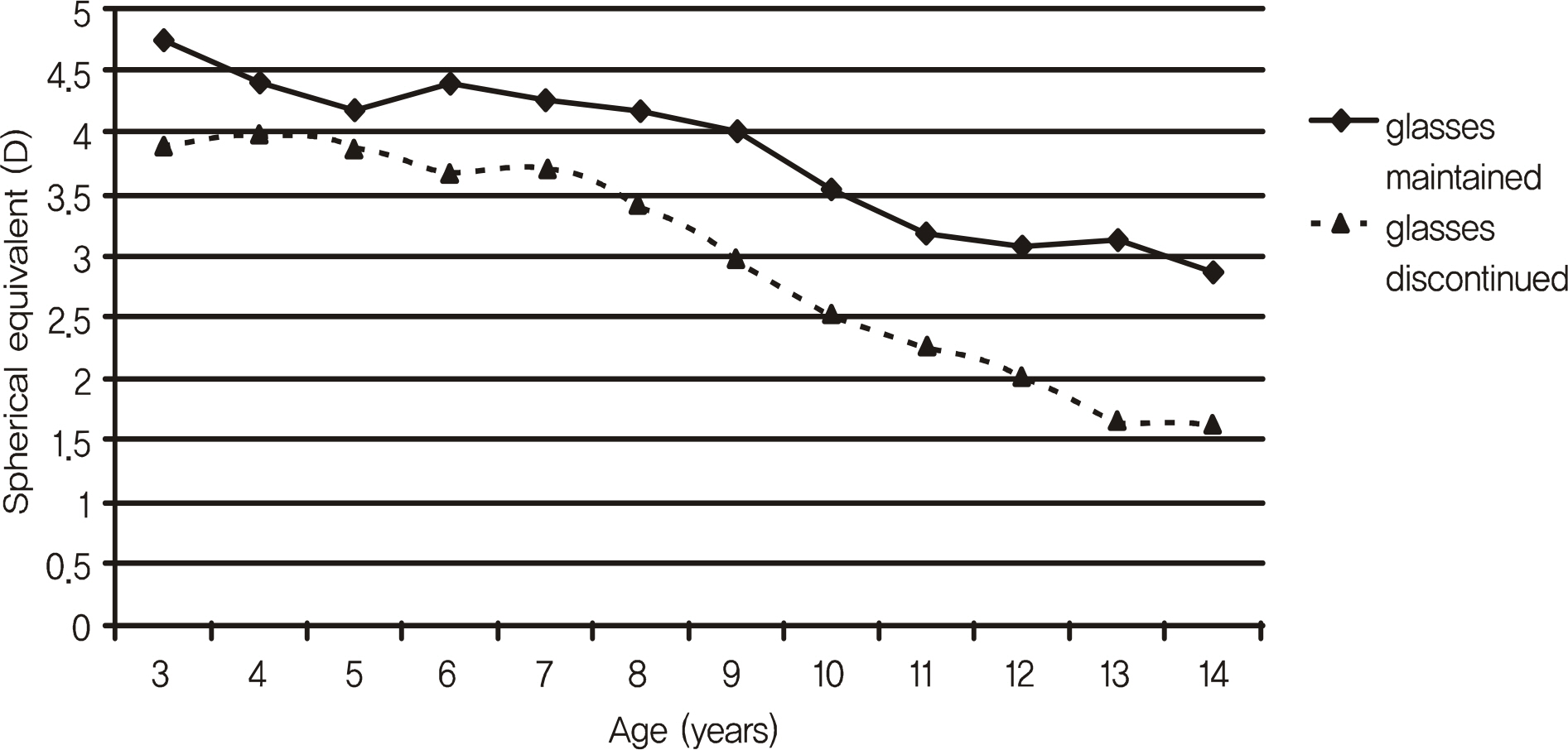J Korean Ophthalmol Soc.
2011 Feb;52(2):227-232.
Predictive Factors of Successful Weaning From Glasses in Accommodative Esotropia Patients
- Affiliations
-
- 1Department of Ophthalmology, Mokdong Hospital, Ewha Womans University School of Medicine, Seoul, Korea. Limkh@ewha.ac.kr
- 2Department of Ophthalmology, National Medical Center, Seoul, Korea.
Abstract
- PURPOSE
To investigate the predictive factors of successfully weaning children from glasses with accommodative esotropia who were monitored with manifest refraction on follow-up visits.
METHODS
A retrospective review of 48 patients with accommodative esotropia was performed. Weaning was accomplished by monitoring patients with manifest refraction on follow-up visits. The patients were divided into 2 groups: patients who were weaned successfully from glasses and patients who still needed glasses at their final visit. A comparative analysis of the multiple clinical features between the 2 groups was performed.
RESULTS
Among the 48 patients, 15 patients were weaned successfully from glasses. The age of onset was significantly different between the 2 groups, 39.6 +/- 14.9 months in patients who were weaned successfully from glasses and 30.7 +/- 16.9 months in patients who still needed glasses. In particular, the patients with onset of accommodative esotropia after 3 years of age were more likely to be weaned from glasses at their final visit.
CONCLUSIONS
Monitoring with manifest refraction could be another method of weaning children from glasses with accommodative esotropia and the age of onset appears to be the useful predictor of successful weaning in children who can finally be weaned from glasses.
MeSH Terms
Figure
Reference
-
References
1. Mohney BG. Common forms of childhood esotropia. Ophthalmology. 2001; 108:805–9.
Article2. Von Noorden GK. Binocular vision and ocular motility. 6th edition.St. Louis: The C.V. Mosby Co;2002. p. 16.3. Wright KW, Spiegel PH. Pediatric ophthalmology and strabismus. 2nd ed.Springer;2003. p. 13.4. Rubin SE. Bringing the management of accommodative esotropia into sharp focus. Am J Ophthalmol. 2006; 141:914–5.
Article5. Repka MX, Wellish K, Wisnicki HJ, et al. Changes in the refractive error of 94 spectacle-treated patients with acquired accommodative esotropia. Binocul Vis. 1989; 4:5–21.6. Mulvihill A, MacCann A, Flitcroft I, O'keefe M. Outcome in refractive accommodative esotropia. Br J Ophthalmol. 2000; 84:746–9.
Article7. Hutcheson KA, Ellish NJ, Lambert SR. Weaning children with accommodative esotropia out of spectacles: a pilot study. Br J Ophthalmol. 2003; 87:4–7.
Article8. Lambert SR, Lynn M, Sramek J, Hutcheson KA. Clinical features predictive of successfully weaning from spectacles those children with accommodative esotropia. J AAPOS. 2003; 7:7–13.
Article9. Lee TY, Kim MM. Clinical characteristics of accommodative esotropia with successful wearing out of glasses. J Korean Ophthalmol Soc. 2007; 48:1699–705.
Article10. Hiatt RL, Braswell R, Smith L, Patty JW. Refraction using mydriatic, cycloplegic, and manifest techniques. Am J Ophthalmol. 1973; 76:739–44.
Article11. Seong GJ, Choi O. Comparison of near retinoscopy, retinoscopy under cycloplegia and subjective refraction. J Korean Ophthalmol Soc. 1987; 28:143–9.12. Moon NJ, Kim JC, Koo BS. The study on the necessity of cycloplegic refraction in school children. J Korean Ophthalmol Soc. 1988; 29:377–85.13. Cho YA, Baek SW. Clinical assessment of accommodative esotropia. J Korean Ophthalmol Soc. 1988; 29:371–8.14. Yang H, Chang YH, Lee JB. Clinical features of refractive accommodative esotropia and partially accommodative esotropia. J Korean Ophthalmol Soc. 2004; 45:626–30.15. Somer D, Cinar FG, Duman S. The accommodative element in accommodative esotropia. Am J Ophthalmol. 2006; 141:819–26.
Article16. Raab EL. Hypermetropia in accommodative esodeviation. J Pediatr Ophthalmol Strabismus. 1984; 21:P64–8.17. Berk AT, Koçak N, Ellidokuz H. Treatment outcomes in refractive accommodative esotropia. J AAPOS. 2004; 8:384–8.
Article18. Lim SJ, Lee SY, Lee YC. Change of refractive error in patients with refractive accommodative esotropia. J Korean Ophthalmol Soc. 2007; 48:822–7.
- Full Text Links
- Actions
-
Cited
- CITED
-
- Close
- Share
- Similar articles
-
- Clinical Characteristics of Accommodative Esotropia with Successful Wearing out of Glasses
- Changes in Hypermetropic Spectacle Correction after Surgery in Partially Accommodative Esotropia
- The Effect of Laser in Situ Keratomileusis in Accommodative Esotropia
- Clinical Studies on Accormmodative Esotropia
- Clinical Assessment of Partially Accommodative Esotropia



